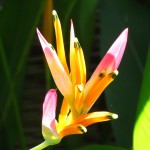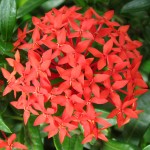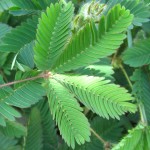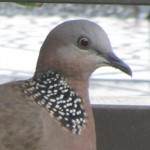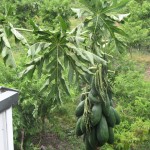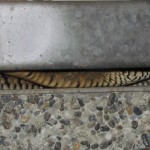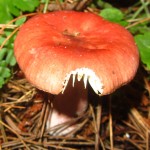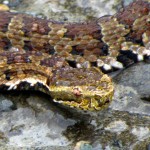Flora and Fauna of Tropical Asia
The fascinating world of tropical nature
False Bird of Paradise
The Heliconiaceae family of plants is characterised by a large variety of astonishingly beautiful flowers of improbable shapes. The False Bird of Paradise (Heliconia psittacorum) is no exception. Also known as Parakeet Flower, Parrot’s Beak or Parrot’s Flower, this popular perennial originating from Central and South America provides a striking combination of colours – from its lovely pink bracts to strong orange-coloured flowers with dark green spots and white tips. It is widely cultivated in many parts of the tropics, often as hybrids or in colour varieties that differ considerably from the “original”, but still remain highly impressive.… Continue reading
Ixora or Jungle Geranium
Ixora is a genus of a flowering shrub from the Rubiaceae family. There are hundreds of species and cultivated varieties that grow in numerous tropical gardens throughout the world. Perhaps the most popular among them is an ixora commonly referred to as jungle geranium or jungle flame (Ixora coccinea), a plant native to southern India and Sri Lanka, but now inexorably (pun intended) grown as an ornamental especially for its numerous showy flowers and excellent quality as a hedge. The flowers come in many different colours, including scarlet, red, pink and yellow, thus providing a lovely contrast… Continue reading
Touch-Me-Not
Seeing a wild animal advancing rapidly through its habitat is nothing unusual. But watching a plant perform rapid evasive movement, that’s truly unforgettable. The sensitive mimosa (Mimosa pudica), also known as “touch-me-not”, is an astonishing plant in the sense that it will literally disappear in front of your eyes within seconds after coming into physical contact with it. The speed at which the herb folds its two rows of small leaves at a slightest touch is unparallelled in nature. It has never been reliably explained why this perennial, native to tropical Central and South America, evolved in this… Continue reading
Spotted Dove
Witnessing the behaviour of animals in nature and their relationships is never short of astonishing. The case of the rescued Spotted dove (Spilopelia chinensis) baby, which was cruelly expunged from its nest by the powerful typhoon Soulik over the weekend, is an excellent example. I’ve been hand-feeding the (estimated) 10-day old baby bird for the last two days, literally forcing it to have a warm millet mixture twice a day. The bird’s reluctance to open its beak and accept food from an unfamiliar source seems to stress it out somewhat. However, there is one thing that cheers up… Continue reading
Hand-Raising Spotted Dove Chick
Typhoons can cause enormous damage not only to plants and farms, but also to wild animals. One of the victims of the foul weather earlier this week was a baby dove, found sitting in a state of shock on my neighbour’s lawn. With the bird’s parents nowhere to be found, the neighbour brought the baby dove to me. “You keep birds, you must know a thing or two about them,” he said handing the poor wet creature to me. I do indeed have an aviary and even some experience with hand-raising baby parrots. However, it’s one thing bringing up a… Continue reading
Typhoon Soulik
One of the less pleasant aspects of living on islands or in the coastal areas of climatically warmer zones is the threat of devastating tropical storms. These are usually referred to as typhoons, hurricanes, tropical depressions or cyclones, depending on the geographical location where they occur, but they are essentially the same thing – vast thunderstorms with sustained winds of at least 119 kilometres per hour and an “eye” of relative calm in the centre of it, clearly visible on satellite pictures. Many scientific studies have been published on the formation and subsequent movements of these storms, but suffice to… Continue reading
Snake in Aviary
High drama in the aviary for the past two days. On Monday evening, when I walked into the shed which is attached to the house and where a fenced-off area serves as a small aviary for our three parrots, I was welcomed by a large snake crawling on the ground, just a metre or so away from my feet! I rushed to get my snake tong, but by the time I returned to the shed I could only watch the snake’s tail rapidly disappearing in a corner of the aviary, in a narrow opening. The shed is supported by several… Continue reading
From Coral Beach to Alpine Country in Three Hours
Southern Taiwan is an extraordinary place in many ways. With a hot and humid climate, colourful coral formations, sandy beaches, and vast tropical fruit orchards, it clearly belongs to the warm regions of our planet. Nevertheless, it is sometimes easy to forget that southern Taiwan is also home to a massive mountain range covering the central areas of the island, with the highest peak reaching a whopping 3,995 metres! Yushan, as the summit is called, is 47 kilometres south of the Tropic of Cancer, so technically it still finds itself in the tropics. However, at this altitude and with alpine… Continue reading
Kikuchi’s Habu or Mountain Pit Viper
Yesterday was my lucky day. Kikuchi’s habu or Taiwan mountain pit viper (Trimeresurus gracilis) is an endemic species of snake that is very rarely seen, mainly because it only lives in less populated altitudes of over 2,000 metres above sea level. It is a related but separate species from the much more common Chinese habu (which is allegedly responsible for more snake bites than any other snake on the island). Unlike its nocturnal name sake, Kikuchi’s habu, named after a Japanese researcher who studied the pit viper in the early 20th century, is diurnal and also much smaller,… Continue reading
